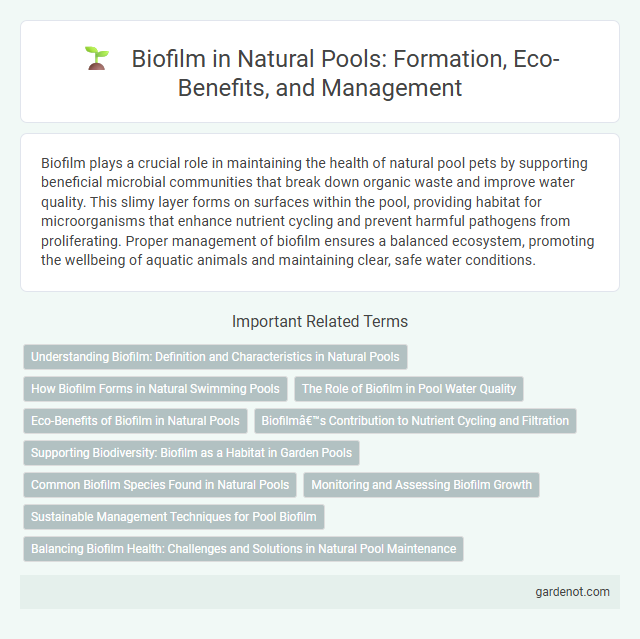Biofilm plays a crucial role in maintaining the health of natural pool pets by supporting beneficial microbial communities that break down organic waste and improve water quality. This slimy layer forms on surfaces within the pool, providing habitat for microorganisms that enhance nutrient cycling and prevent harmful pathogens from proliferating. Proper management of biofilm ensures a balanced ecosystem, promoting the wellbeing of aquatic animals and maintaining clear, safe water conditions.
Understanding Biofilm: Definition and Characteristics in Natural Pools
Biofilm in natural pools refers to the complex layer of microorganisms, including bacteria, algae, and fungi, that adhere to surfaces within the aquatic environment. This biological matrix protects the microorganisms while facilitating nutrient cycling and enhancing water quality through natural filtration processes. Understanding biofilm's structure and function is essential to maintaining balanced ecosystems and optimizing the sustainability of natural pool systems.
How Biofilm Forms in Natural Swimming Pools
Biofilm in natural swimming pools forms when microorganisms such as bacteria and algae adhere to surfaces like rocks, plants, and pool walls, creating a slimy matrix of extracellular polymeric substances (EPS). These microorganisms attach quickly, especially in nutrient-rich water, establishing microcolonies that develop into complex communities shielded by the EPS layer. Factors such as water temperature, sunlight exposure, and organic matter contribute to the rapid proliferation and stabilization of biofilm within the natural pool ecosystem.
The Role of Biofilm in Pool Water Quality
Biofilm plays a crucial role in maintaining natural pool water quality by supporting beneficial microbial communities that break down organic matter and reduce harmful pathogens. These microbial mats enhance nutrient cycling and contribute to the biological filtration process, promoting clear and balanced water conditions without chemical additives. Proper management of biofilm ensures a stable ecosystem, preventing algae overgrowth and maintaining a healthy habitat for aquatic plants and organisms.
Eco-Benefits of Biofilm in Natural Pools
Biofilm in natural pools plays a crucial role in maintaining water clarity and enhancing ecosystem health by breaking down organic matter and pollutants through microbial activity. These microbial communities support nutrient cycling and provide habitat for beneficial microorganisms, which helps reduce the need for chemical treatments. Biofilm contributes to the natural filtration process, promoting sustainable and eco-friendly water management in natural swimming pools.
Biofilm’s Contribution to Nutrient Cycling and Filtration
Biofilm in natural pools plays a crucial role in nutrient cycling by breaking down organic matter and converting nutrients into forms accessible to aquatic plants. This microbial layer enhances filtration by trapping suspended particles and promoting microbial degradation, thereby improving water clarity. The diverse microbial communities within biofilms facilitate nitrogen and phosphorus cycling, essential for maintaining ecological balance in natural pools.
Supporting Biodiversity: Biofilm as a Habitat in Garden Pools
Biofilm in natural pools serves as a crucial habitat, fostering a complex ecosystem of microorganisms, algae, and microinvertebrates that support overall biodiversity. This biofilm layer promotes nutrient cycling and water purification, enhancing the ecological balance of garden pools. By providing shelter and food sources for aquatic species, biofilm helps sustain a resilient and vibrant aquatic community.
Common Biofilm Species Found in Natural Pools
Common biofilm species found in natural pools include cyanobacteria, green algae, and diatoms, which play a crucial role in ecosystem balance by filtering nutrients and providing habitat for microfauna. Bacterial genera such as Pseudomonas and Bacillus are frequently present, contributing to organic matter decomposition and nutrient cycling. These biofilms help maintain water clarity and quality by stabilizing sediments and supporting diverse microbial communities essential for a healthy natural pool environment.
Monitoring and Assessing Biofilm Growth
Effective monitoring and assessing of biofilm growth in natural pools involves regular sampling and microscopic analysis to detect early biofilm formation on surfaces. Utilizing sensors measuring parameters such as temperature, pH, and nutrient levels helps track conditions that promote biofilm development. Implementing biofilm-specific staining techniques and ATP bioluminescence assays provides accurate quantification of microbial biomass, ensuring timely management and maintenance of water quality.
Sustainable Management Techniques for Pool Biofilm
Effective sustainable management of biofilm in natural pools relies on regular monitoring using microbial testing and employing enzymatic cleaners to disrupt biofilm matrix without harming aquatic ecosystems. Integrating biological control methods, such as introducing biofilm-degrading bacteria, enhances natural biodegradation processes and reduces chemical usage. Optimizing water circulation and maintaining balanced nutrient levels further prevent biofilm overgrowth, ensuring ecological stability and water clarity.
Balancing Biofilm Health: Challenges and Solutions in Natural Pool Maintenance
Balancing biofilm health in natural pools involves managing microbial communities that contribute to water purification and ecosystem stability. Challenges include preventing excessive biofilm buildup that can lead to clogged filtration systems and undesirable odors. Solutions focus on maintaining optimal nutrient levels, promoting beneficial microbial diversity, and employing regular mechanical cleaning to support sustainable biofilm function.
Biofilm Infographic

 gardenot.com
gardenot.com